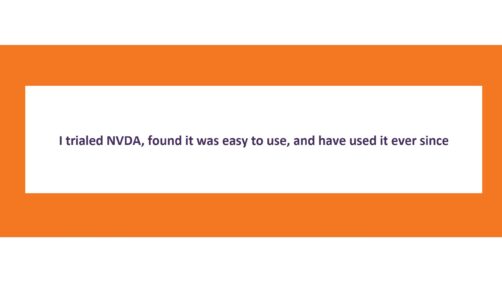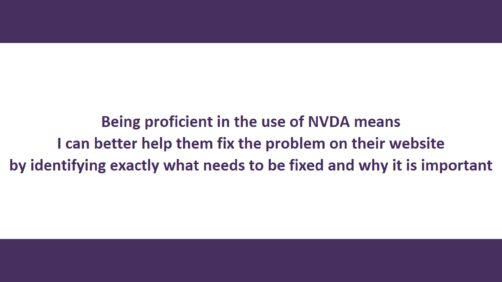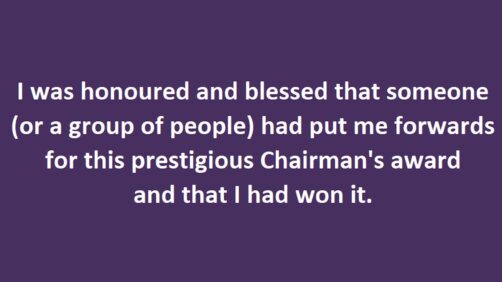Gene has been an NVDA user since the early days. He was one of the first NVDA Certified Experts, and has championed NVDA across the length of New Zealand. He recently shared some of his experiences with Quentin. The audio version of this text is being read by NVDA using the eSpeak-NG “Edward” voice (based on the earlier NV Speech Player) at 70%. The full text transcript is below:
Quentin: How long have you used NVDA? What made you interested in trying it?
Gene: I have used NVDA since early 2007 or thereabouts.
Having the eyesight condition Retinitis Pigmentosa, I was in the in-between world of needing magnification to see what I could still see but in a larger format (whether this be by handheld magnifier or software on a computer). The Windows magnifier back then was not really helpful for what I needed it for and Narrator was quite basic. I could not afford the commercial alternatives at that time, and was not aware initially that a person could get funding for these products. I was told later that you had 3 alternatives: get a job and it would be government funded; fund it yourself; or have someone else pay for it within your community if you were studying (eg. A local grant scheme). At the time, I had enrolled into a Business Administration and Computing course and was provided with an assistant, but they could not fund the software that I needed at that time. A couple of months into my course, I was using a commercial magnification programme (which was funded by a local Trust under their Education grants – as I met the Trust’s criteria and was studying at the time). I graduated from my 12 month course in just 6 months, but was not successful in gaining employment where we live out here in a country town as there were not many employment opportunities. To gain employment, you needed to be able to travel to your destination via a car or public transport and being blind I no longer had a licence, and out here buses were non existent back then. If you lived in a city then there might have been more opportunities back then. It wasn’t until I went to upgrade the software and found out how much each upgrade cost that I looked for an alternative. I was told that when you get to about 6x magnification that you should really be starting to use a screen reader, so I started looking for alternatives when NVDA came up in a search for free screen readers. I trialed NVDA, found it was easy to use (even though it was quite basic back then) and have used it ever since. The thing that got me is that I didn’t have to reboot my computer every 40 minutes like you do with trial versions of other screen readers. Back then, what interested me in trying NVDA was that you could have as many copies of NVDA as you needed, upgrades were free (unless you chose to donate to this worthy project to keep it going and free for everyone), and it was so easy to use.

Quentin: You were our first NVDA Certified Expert in New Zealand, and one of our earliest NVDA Certified Experts. Firstly, congratulations! Secondly, what benefits have you found from having the certification?
Gene: Thank you Quentin. I was glad when that became available as it was one of my goals to become New Zealand’s first NVDA screen reader graduate (if/when it became available back then). Even before the qualification was on offer, someone once said to me that anything to do with NVDA here in New Zealand would be referred to me as I was a fulltime NVDA screen reader user and had started setting up a homepage to do with blindness and NVDA tutorials. At a later date I bought a domain name. Back then, I found it easier to put any NVDA questions that I was asked onto a webpage with answers, and then send off a link via email to people.
In 2008, a local newspaper did an article when I was able to get access to the Stratford library public computers using NVDA. The NVDA screen reader was then installed onto the Stratford library network. This was later rolled out nationwide.
In 2009 I received a national certificate called the Extra Touch Award from the Association of Blind Citizens NZ (now known as BCNZ) for assisting blind and vision impaired people to achieve independence. It was the first time they had awarded it jointly (the other recipient being the New Zealand library network) and it was the first time a third party screen reader had gone onto a nationwide computer network.
It was a nice acknowledgement of my achievement locally, but at the same time promoted the NVDA screen reader internationally, as it was an online publication.
When I have knocked on doors for other projects (such as government departments), having the certification (since 2017) has given me credibility as well, meaning that doors seem to open up where otherwise they may have remain closed. I guess a little bit of prayer helps as well. It does also help to research your project thoroughly first and if it is for the community then doors will be opened most of the time. It has also given credibility when trying to get a company to make their website/s more user friendly as being proficient in the use of NVDA means I can better help them fix the problem on their website by identifying exactly what needs to be fixed and why it is important for me and others using it.

Recently (in January 2025) I passed the NVDA Certified Expert exam for the 4th time to keep up my proficiency with NVDA.
Quentin: You have been instrumental in getting NVDA rolled out across libraries in NZ. Why is this important? And did you face any barriers to accomplish this?
Gene: Thanks Quentin. Being able to access public computers with NVDA nationwide helps everyone in the community.
My first barrier was after the APNK (Aotearoa People’s Network Kaharoa) first came to town, they installed computers into our local libraries and libraries throughout New Zealand, but they had login software which I could not use. I was forced to use Narrator if I wanted to use one of those computers. Around this time, as I was using NVDA and could take it portable, I took a USB stick with NVDA on it to the library to use there. I spoke to the library Manager (Jonet) and she directed me to contact another IT person at APNK. I was told initially that they had EXE blocking software and that it would have to be tested and the code looked through before they could unblock it. Once they had done this, they put a copy of NVDA onto each computer in the Stratford library, then after that took it nationwide. Sadly, ten or so years later, the libraries on the APNK network changed from Windows across to Chromebooks (which do not support NVDA). Christchurch and Auckland library networks still support NVDA. The only other barrier for the Auckland region was that although NVDA had been installed on their network, someone had forgotten to post it on their software page at that time so nobody knew the NVDA screen reader was on their library network.
Quentin: You recently received the “Blind / Low Vision NZ’s Chair’s Award”. Tell us about that and the experience?
Gene: In November 2023, I got a random phonecall from Blind Low Vision NZ, and they said I had been put forward for their national Chairman’s award. This award is in recognition of outstanding achievements and contribution to the lives of blind and low vision New Zealanders.
I was told that I was in the top 3 people who were nominated for this award and I was asked to go to Christchurch to an AGM held on Saturday 11/11/23. It was not until about 11am or so that the winner of the Chairman’s award was mentioned. When the Chairman said the winner of this year’s Chairman’s Awards goes to a person who created a website Accessibilitycentral.net then mentioned a few of my pages; he said who else would have a page on their site called TV commercials that do not make sense. I just wanted to hide.
I was honoured and blessed that someone (or a group of people) had put me forwards for this prestigious Chairman’s award and that I had won it.

It showed that what had started off as a homepage with blindness related information, along with NVDA tutorials, people appreciated what I had put together. By passing on my knowledge of using NVDA to new users of the NVDA screen reader, my aim was to help people in the same boat as me; as well as sighted people in the community to learn ways that they could help us out in the community.
When I was either recording or writing up an NVDA tutorial, I would write or record it step by step for others to follow. I did not think that what I had started back then, would turn out to be what you see today – a very useful resource for the visually impaired, blind and the public alike.
Read about this national BLVNZ Chairman’s Award 2023 and what it is for at BlindLowVision.org.nz.
Quentin: What is next for Gene?
Gene: I guess that is the million dollar question. I guess that while I am still able to, it is to be continuing to add useful information to the website. I would like to keep on with my advocacy to help the blind and visually impaired and print disabled in whatever way I can. It might be software testing, website testing and feeding back to the developers of both platforms (both the internet and mobile phones). I love pointing out problems to whoever an issue needs to be referred to, or even in some cases recording what I hear, and feeding back. When it is fixed, it helps more than just me.
Even out in the community, when I get the chance, I like speaking to sighted people about problems we may have in the blind community and how they can help. Putting people in our shoes and changing their life (for even just 5 minutes) in terms of barriers we come across (either in the home, out in the community, or when demonstrating problems with websites or mobile apps in the online world etcetera) can help others to better understand the issues that we may face from time to time. Something as simple as labels on a can of baked beans, spaghetti or fruit salad can be easy to identify for a sighted person, unless the labels are taken off. In the same way a sighted person can see a website but a blind person needs the website labeled correctly so that the screen reader can read it to them (whether this be in forms, buttons or descriptive alt text for photos etcetera). Something as simple as a play button has no meaning if not labeled correctly.
As mentioned by the BLVNZ chair previously, another thing that I am keen to see changes in are TV ads that are not as accessible as radio ads. It just makes sense to have as wide an audience as possible. Having an ad that is visual only (such as a logo, phone number etcetera) with strange sounds is no good if the product details or the contact number or logo is not spoken out. If you could not see the ad, how would you know what the product is or where you could buy it from etcetera?
I would like to see NVDA listed as a useful resource on Education sites as it can help many people. Many education sites may not be aware of this very useful resource for blind, vision impaired and print disabled users.
NVDA has helped me with all of my past projects (such as creating my Accessibility Central website, emailing government departments, keeping up to date with projects and information, and so much more) and will be continuing to help me with my future projects whatever they may be.
One of my current / future projects will be to continue to promote NVDA. In my most recent voluntary appointment, I have just become a committee member of a trust for the blind in Taranaki. I know NVDA will be invaluable in my work with the trust and at the same time be able to help other people in the same boat as me (who may require an affordable screen reader) in our blind/ low vision community.
Thank you to Michael Curran for creating NVDA, James Teh and others for developing NVDA, all who have helped with coding, donations, and promoting the screen reader. I think that back then when it first started, Mick (then James) would have had no idea just how much of an effect that NVDA would later have on so many people around the world.
Gene NZ
Quentin: Thank you Gene, And thank you for reading. If you’d like to join Gene as an NVDA Certified Expert, please go to certification.nvaccess.org.